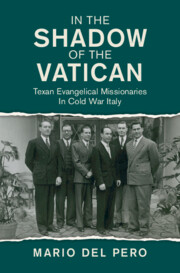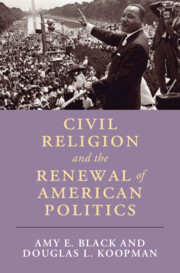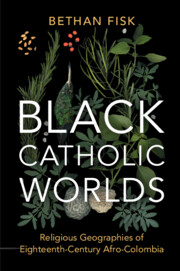Refine search
Actions for selected content:
203 results
Chapter 3 - Religion Onstage
- from Part II - In Practice
-
- Book:
- Theatre and Censorship in France from Revolution to Restoration
- Published online:
- 30 November 2025
- Print publication:
- 18 December 2025, pp 105-133
-
- Chapter
- Export citation
29 - Francis Webb
-
-
- Book:
- The Cambridge History of Australian Poetry
- Published online:
- 19 November 2025
- Print publication:
- 11 December 2025, pp 538-557
-
- Chapter
- Export citation
28 - Religion and Poetry in Australia
-
-
- Book:
- The Cambridge History of Australian Poetry
- Published online:
- 19 November 2025
- Print publication:
- 11 December 2025, pp 523-537
-
- Chapter
- Export citation

Irish Romanticism
- A Literary History
-
- Published online:
- 27 November 2025
- Print publication:
- 11 December 2025
1 - “In the Shadow of the Vatican”
-
- Book:
- In the Shadow of the Vatican
- Published online:
- 23 October 2025
- Print publication:
- 06 November 2025, pp 14-59
-
- Chapter
- Export citation

In the Shadow of the Vatican
- Texan Evangelical Missionaries in Cold War Italy
-
- Published online:
- 23 October 2025
- Print publication:
- 06 November 2025
5 - Catholics
- from Part II - Religious Traditions
-
- Book:
- Civil Religion and the Renewal of American Politics
- Published online:
- 09 October 2025
- Print publication:
- 23 October 2025, pp 79-103
-
- Chapter
- Export citation

Civil Religion and the Renewal of American Politics
-
- Published online:
- 09 October 2025
- Print publication:
- 23 October 2025
Chapter 6 - Michael Field’s Catholicism
- from Part I - Works and Days
-
-
- Book:
- Michael Field in Context
- Published online:
- 03 October 2025
- Print publication:
- 25 September 2025, pp 48-56
-
- Chapter
- Export citation
Chapter 27 - Michael Field and Post-Victorian Decadence
- from Part V - Afterlives and Future Fields
-
-
- Book:
- Michael Field in Context
- Published online:
- 03 October 2025
- Print publication:
- 25 September 2025, pp 259-267
-
- Chapter
- Export citation
Chapter 14 - Whym Chow: Flame of Love and Animal Poetry
- from Part II - Forms and Genres
-
-
- Book:
- Michael Field in Context
- Published online:
- 03 October 2025
- Print publication:
- 25 September 2025, pp 123-132
-
- Chapter
- Export citation

Black Catholic Worlds
- Religious Geographies of Eighteenth-Century Afro-Colombia
-
- Published online:
- 28 August 2025
- Print publication:
- 11 September 2025
Chapter 4 - Doubting Thomas
-
- Book:
- Zola's Dream
- Published online:
- 07 August 2025
- Print publication:
- 21 August 2025, pp 166-209
-
- Chapter
- Export citation
7 - Joyce the Irishman
-
-
- Book:
- The Cambridge Companion to James Joyce
- Published online:
- 14 August 2025
- Print publication:
- 21 August 2025, pp 120-135
-
- Chapter
- Export citation
Chapter 5 - On Being Right
-
- Book:
- Zola's Dream
- Published online:
- 07 August 2025
- Print publication:
- 21 August 2025, pp 210-251
-
- Chapter
- Export citation
5 - Women’s Networks
-
- Book:
- Christianity at the Crossroads
- Published online:
- 19 May 2025
- Print publication:
- 31 July 2025, pp 146-178
-
- Chapter
- Export citation
Chapter 1 - Domestic Religion in Seventeenth- and Eighteenth-Century London
-
- Book:
- Birth, Death, and Domestic Religion in Early Modern London
- Published online:
- 17 July 2025
- Print publication:
- 31 July 2025, pp 28-63
-
- Chapter
- Export citation
Introduction
-
- Book:
- Christianity at the Crossroads
- Published online:
- 19 May 2025
- Print publication:
- 31 July 2025, pp 1-12
-
- Chapter
- Export citation
Canadian Catholic Health Care at the Nexus of Multiple Legal Regimes
-
- Journal:
- Canadian Journal of Law & Society / La Revue Canadienne Droit et Société , First View
- Published online by Cambridge University Press:
- 25 July 2025, pp. 1-21
-
- Article
-
- You have access
- Open access
- HTML
- Export citation
Chapter 14 - Religion
- from Part II - Social Contexts
-
-
- Book:
- Sean O'Casey in Context
- Published online:
- 23 June 2025
- Print publication:
- 10 July 2025, pp 150-158
-
- Chapter
- Export citation
